Selecting the perfect full-suspension carbon frame involves balancing multiple technical factors that directly impact your riding experience. Trifox offers two exceptional but distinct options: the Trail II Pro and the MFM100. Both utilize high-modulus carbon fiber and modern engineering, yet differ significantly in their approach to geometry, suspension design, and component compatibility. Understanding these differences will help you choose the frame that best matches your riding style and trail requirements.
Geometry & Riding Position: XC Efficiency vs Trail Confidence
The MFM100 is engineered for cross-country performance. Its geometry features a steeper head tube angle (around 68–69°) and a shorter reach, creating an upright, efficient pedaling position ideal for climbing and accelerating on undulating terrain. This is a classic XC mountain bike frame philosophy—prioritizing speed and efficiency over sheer stability.
Conversely, the Trail II Pro embraces modern trail bike geometry. With a slacker head tube angle (approximately 67–68°) and a longer front center, it positions the rider lower and further between the wheels. This "in-the-bike" stance inspires confidence on steep descents and provides superior stability at high speeds, making it the clear choice for technical, aggressive trail riding.
Suspension Design & Installation: A Key Differentiator
Here lies a major technical distinction. While both frames use a sophisticated four-bar linkage system, their suspension design and shock installation differ to serve their intended purposes.
The Trail II Pro typically employs a more traditional shock mount placement, with the shock oriented vertically or at a slight angle between the top tube and the seat stay/chainstay intersection. This layout prioritizes a linear to moderately progressive curve, focusing on pedaling efficiency, mid-stroke support, and quick recovery—perfect for maintaining momentum on climbs and flow trails.
The MFM100 often features a low main pivot design with the shock mounted lower in the frame, between the down tube and the front of the swingarm. This configuration, combined with a higher leverage ratio, creates a more progressive suspension curve. It offers greater small-bump sensitivity for traction and ramps up significantly at the end of the travel to handle big impacts without bottoming out harshly. This design favors descending capability and all-mountain performance.
Rear Derailleur Hanger: The Critical Link to Your Drivetrain Choice
This is a core difference that affects your drivetrain selection and future upgrade path.
The Trail II Pro is equipped with a UDH (Universal Derailleur Hanger). This design provides a crucial compatibility advantage. The UDH hanger is a mandatory requirement for installing the SRAM Eagle Transmission groupset—a widely used and beloved wireless electronic shifting system known for its extreme performance, reliability, and simplicity. At the same time, the UDH is fully compatible with all traditional Shimano and SRAM mechanical or electronic derailleurs. Choosing the Trail II Pro means you can freely select any mainstream groupset available today and also have the door open for a future seamless upgrade to the top-tier SRAM Eagle Transmission, ensuring the frame's long-term value and technical foresight.
The MFM100 uses a standard, model-specific hanger. This traditional hanger can reliably support Shimano groupsets and all SRAM traditional groupsets except for the SRAM Eagle Transmission. However, it cannot be compatible with the UDH-mandatory SRAM Eagle Transmission. This means that if you wish to upgrade to this popular high-performance wireless groupset in the future, you will be limited. Furthermore, if damaged, you must find a specific replacement that exactly matches this frame model.
Weight & Construction Philosophy
Adhering to its XC racing pedigree, the Trail II Pro is the lighterweight carbon frame. Its carbon layup is optimized to shed every possible gram while maintaining precise stiffness for efficient power transfer. It’s designed for riders who count grams and value snappy acceleration.
The MFM100, built to endure the rigors of trail and all-mountain abuse, carries a slight weight penalty. This extra mass comes from strategic reinforcement at high-stress points (like the suspension pivots and chainstay yoke) to ensure long-term durability and impact resistance. The weight is a worthwhile trade-off for the resilience it provides.
Aesthetic & Color Options
Visual identity aligns with each frame's purpose. The Trail II Pro often comes in understated, professional color schemes like matte black, charcoal, or navy—reflecting its racing heritage. The MFM100 tends to offer more vibrant, adventurous finishes, such as glossy electric blue, matte olive green, or two-tone combinations, mirroring its trail-ready character.
The Verdict
Your choice fundamentally depends on your local trails and riding priorities.
- Choose the Trifox Trail II Pro if: You live for climbs, value every gram, participate in XC events, or ride trails where pedaling efficiency and quick handling are paramount. Its efficient suspension and lighter weight make it a rocket on climbs and flowing singletrack. The inclusion of the UDH also makes it the only choice if you plan to use or upgrade to the SRAM Eagle Transmission groupset.
- Choose the Trifox MFM100 if: Your rides feature challenging descents, technical features, and varied terrain. You value stability, traction, and impact absorption. The progressive suspension and modern geometry make it a robust and confident partner for trail adventures, provided you do not require compatibility with the SRAM Eagle Transmission.
Both frames exemplify Trifox's commitment to quality carbon engineering. By carefully weighing their differences in geometry, suspension design, and critical details like the derailleur hanger standard, you can select the carbon foundation that will transform your vision of the perfect mountain bike into reality.
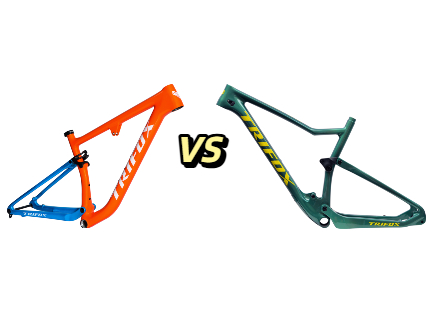

Embarking on the journey to build your dream cross-country (XC) mountain bike is an exciting endeavor. At the heart of this project lies the most critical decision: selecting the perfect frame. A 29er XC full suspension carbon frame represents the ultimate fusion of speed, efficiency, and control, designed to conquer demanding trails while remaining lightweight and responsive.
But with a myriad of options available, how do you ensure you're making the right choice? This comprehensive guide will walk you through the essential factors to consider, using the exemplary TRIFOX Trail II Pro Full Suspension Carbon MTB Frame as a benchmark for what a top-tier frame should offer.
1. Geometry: The Blueprint of Performance
The geometry of a frame is the DNA of your bike's handling characteristics. For modern XC and downcountry riding, the goal is a blend of aggressive climbing efficiency and confident descending stability.
Head Tube Angle (HTA): A slacker HTA boosts stability on technical descents. The TRIFOX Trail II Pro features a 67.5-degree head angle, which is progressive for an XC frame, providing increased confidence when the trail turns downward.
Seat Tube Angle (STA): A steeper STA positions the rider optimally over the bottom bracket, enhancing climbing efficiency and power transfer. The Trail II Pro's 75.5-degree seat angle ensures you can tackle steep climbs effectively.
Reach and Stack: These measurements define your cockpit space and riding posture. Modern geometries tend toward longer reach and lower stack for improved stability and a more aerodynamic riding position.
Why it matters: The right geometry ensures the bike feels intuitive and responsive. The Trail II Pro's geometry strikes a perfect balance, making it adept at both winning races and tackling technical trail features.
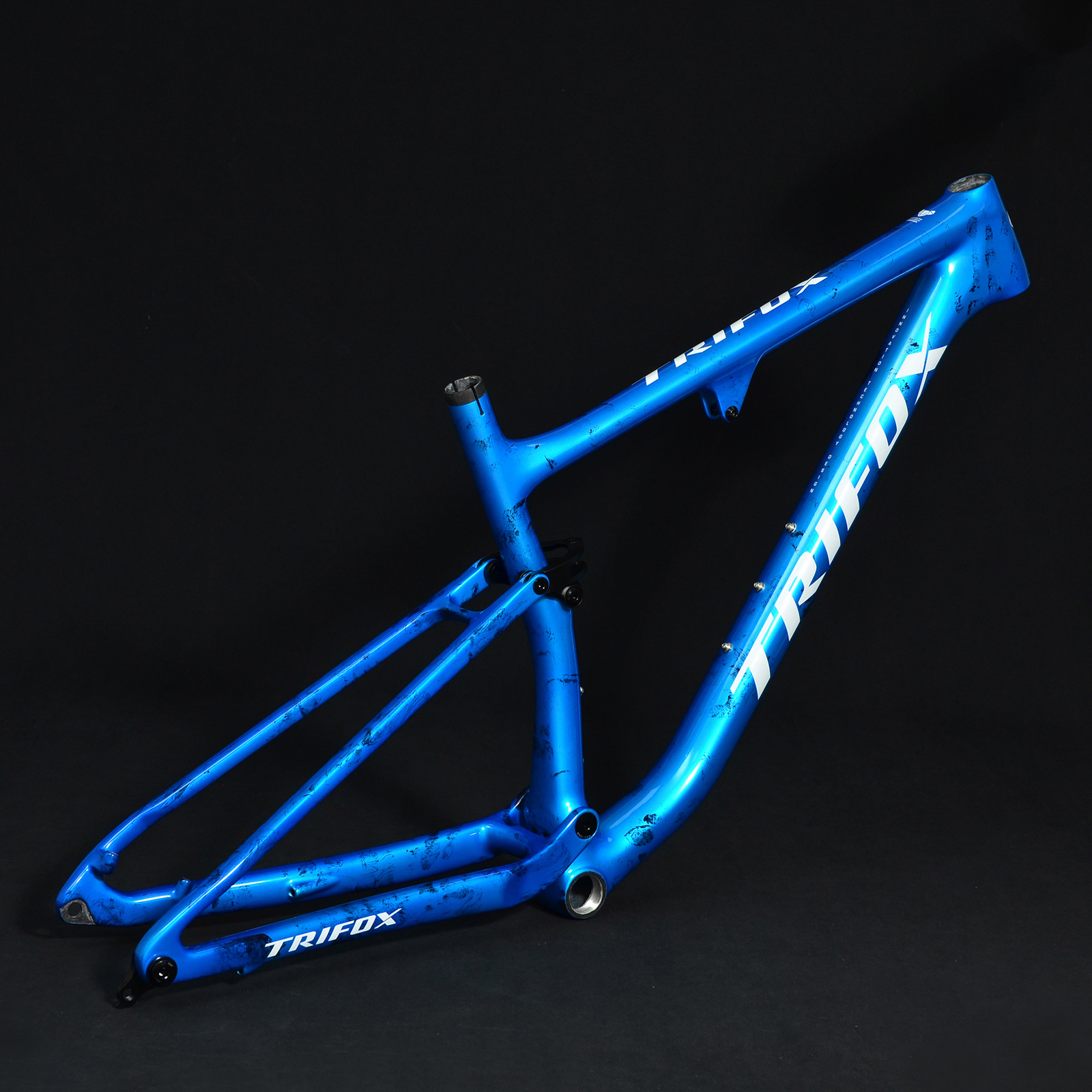
2. Suspension Design: The Heart of the Ride
A full-suspension XC bike must offer traction and comfort without compromising pedaling efficiency. The design of the suspension linkage is paramount.
Linkage Type: The TRIFOX Trail II Pro employs a highly efficient four-bar suspension system. This design is renowned for its ability to minimize pedal bob, ensuring that your energy is directed into forward momentum rather than being absorbed by the suspension.
Travel: For XC purposes, 35-45mm of rear travel is the gold standard. It provides sufficient absorption for rough terrain and maintains grip without sacrificing the snappy, efficient feel essential for climbing and acceleration. The Trail II Pro is designed around this ideal 35-45mm of travel.
Anti-Squat and Kinematics: Advanced suspension kinematics with high anti-squat values keep the frame taut under power, translating to efficient pedaling—a non-negotiable trait for any serious XC frame.
3. Carbon Fiber Quality: Where Engineering Meets Art
The grade and construction of the carbon fiber directly influence weight, stiffness, compliance, and overall durability.
Carbon Grade: Look for frames utilizing high-modulus carbon fibers. The TRIFOX Trail II Pro is crafted from T800 carbon fiber, a premium material that allows for an exceptional strength-to-weight ratio. This results in a frame that is both incredibly light and impressively robust.
Layup Process: The artistry of carbon frame building lies in the layup. Precision hand-laying allows engineers to tailor the flexibility and stiffness in specific areas. The down tube and bottom bracket can be reinforced for stiffness and power transfer, while the seat stays can be designed to offer vertical compliance, smoothing out trail vibrations.
Why it matters: A high-quality carbon frame like the Trail II Pro delivers a ride quality that is stiff and responsive when you stamp on the pedals yet surprisingly comfortable over long, rugged distances.
4. Modern Features and Compatibility: Future-Proofing Your Investment
A modern frame must adhere to current component standards to ensure compatibility and ease of upgrades.
Dropper Post Compatibility: The ability to run a dropper post is essential for modern trail riding. The Trail II Pro features internal routing for a 30.9mm dropper post, allowing for a clean setup and confident descending.
Boost Spacing: The frame boasts 148x12mm Boost rear spacing and 110x15mm front spacing. This standard increases wheel stiffness, improves tire clearance, and enhances overall handling precision.
Threaded Bottom Bracket: A BSA threaded bottom bracket is a signature feature of a well-thought-out frame. It is renowned for its reliability, ease of maintenance, and resistance to creaking—a common issue with press-fit systems.
Internal Cable Routing: Full internal routing for derailleur and dropper posts not only creates a sleek, aesthetic look but also protects the cables from dirt and damage.
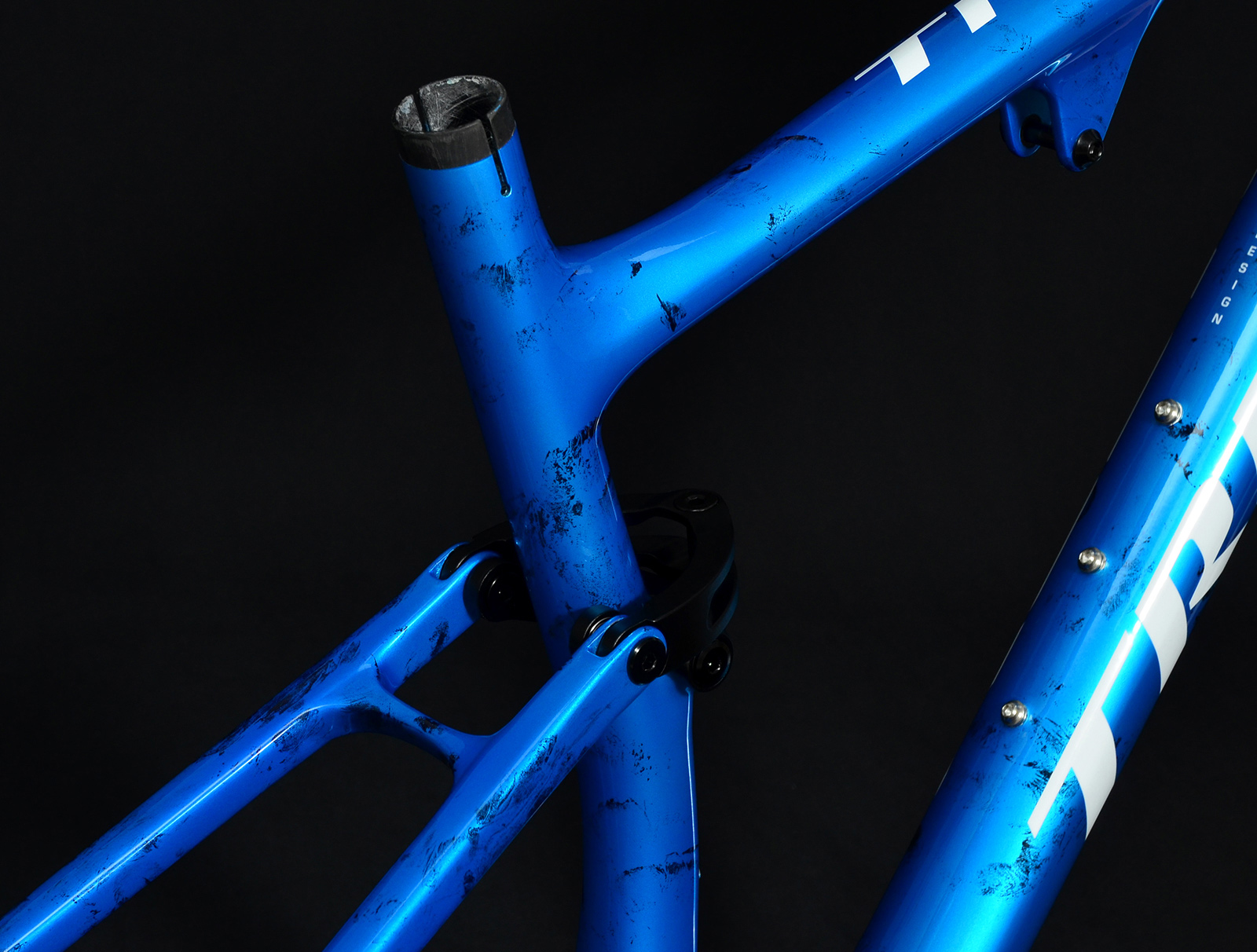
5. Weight and Value Proposition
The pursuit of lightness is central to XC. The TRIFOX Trail II Pro frame weighs approximately 1272g-1336g, placing it firmly in the competitive range for high-performance carbon frames. When evaluating price, consider the value offered by direct-to-consumer brands like TRIFOX, which provide cutting-edge technology and materials at a fraction of the cost of many major brands.
Conclusion: The TRIFOX Trail II Pro – A Paradigm of Intelligent DesignSelecting the perfect frame is a process of matching your riding ambitions with engineering excellence. By focusing on geometry, suspension design, carbon quality, and modern features, you can make an informed decision that will define your ride for years to come.
The TRIFOX Trail II Pro 29er XC Full Suspension Carbon Frame emerges as a standout option that exemplifies these principles:
Its modern geometry inspires confidence across diverse terrain.
The efficient four-bar suspension delivers traction without compromise.
The T800 carbon construction offers a sublime blend of lightness and strength.
Its future-proof features ensure compatibility with the best components on the market.
By using this guide and the Trail II Pro as a reference, you are equipped to choose a frame that will form the foundation of an exceptional mountain bike, ready to push the limits of speed and performance.
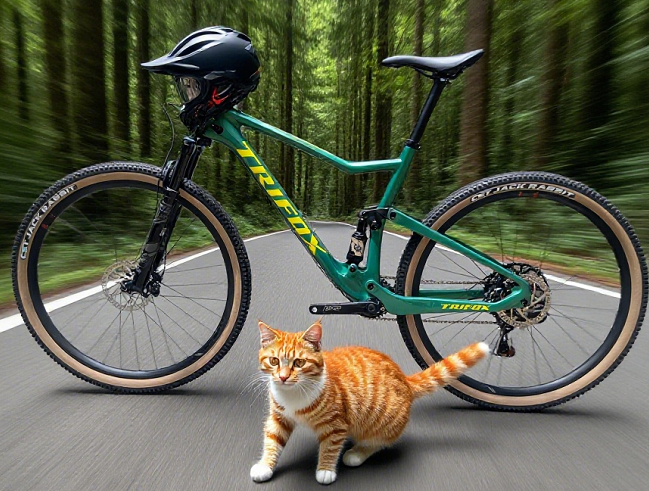
Remember when carbon fiber was reserved for pro pelotons and deep-pocketed racers? Not anymore. Mountain biking is witnessing the unstoppable rise of carbon, transforming trails from XC loops to gnarly enduro descents. Brands like Trifox are making this once-exotic material accessible, proving carbon MTBs aren't just lighter – they're better riding machines. Here's why the shift is seismic:
Featherweight Flight: This is the headline. Carbon frames slash pounds off alloy counterparts. Less weight means easier climbing, quicker acceleration, and less fatigue over long days. You carry the bike less; the bike carries you more. Trifox's carbon hardtails and full-suspension rigs exemplify this advantage, turning arduous ascents into achievable efforts.
Stiffness Meets Sensation: Carbon isn't just light; it's incredibly tuneable. Engineers craft frames with targeted stiffness where it matters most: the bottom bracket for efficient pedaling, the head tube for precise steering. Yet, carbon's magic lies in its ability to also offer vertical compliance. It absorbs smaller trail chatter better than alloy, reducing arm and leg fatigue, letting you ride harder, longer.
Strength You Can Trust: Forget the "fragile" myth. Modern carbon layups create structures incredibly resistant to impacts and fatigue. When designed correctly (like Trifox's robust mountain frames), carbon handles rock strikes, drops, and rough terrain with impressive resilience. It won't dent like aluminum and shrugs off corrosion.
Ride Refined: The combination of lightness, stiffness, and subtle flex translates to a more connected, responsive, and lively feel. You feel the trail without being beaten by it. Carbon bikes track better through corners, feel more nimble in the air, and offer a directness that boosts confidence when pushing limits.
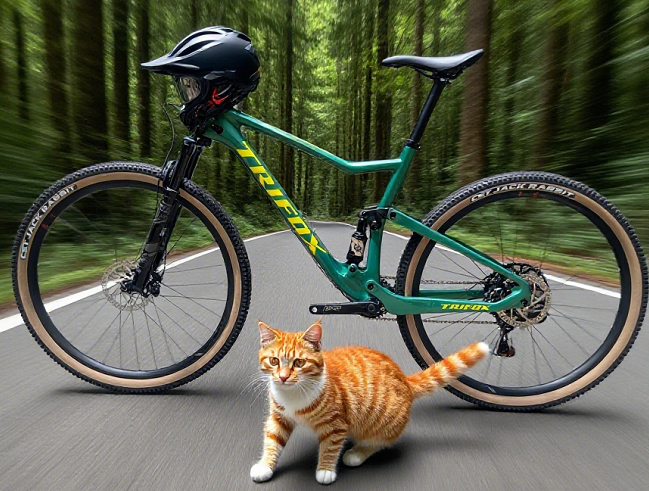
Trifox: Bringing Carbon to the Trail
Brands like Trifox are crucial to this rise. By leveraging efficient manufacturing and direct-to-consumer models, they deliver high-performance carbon mountain bikes at astonishingly competitive prices. Whether it's their agile carbon hardtails perfect for XC and trail blasting, or their capable full-suspension platforms, Trifox proves you don't need a pro contract to experience the carbon revolution.
The Verdict: Not Just a Trend, The Future
The rise of carbon fiber in mountain biking isn't just hype; it's a fundamental shift driven by tangible performance benefits. It offers a superior blend of weight, strength, stiffness, and ride quality that alloy struggles to match. As manufacturing advances and brands like Trifox make it more accessible, carbon is becoming the material of choice for riders seeking every advantage on the trail. It’s not about replacing alloy entirely, but about offering a compelling, high-performance option that’s redefining what’s possible on two wheels. Ready to feel the difference? Explore the carbon evolution: Discover Trifox Mountain Bikes.
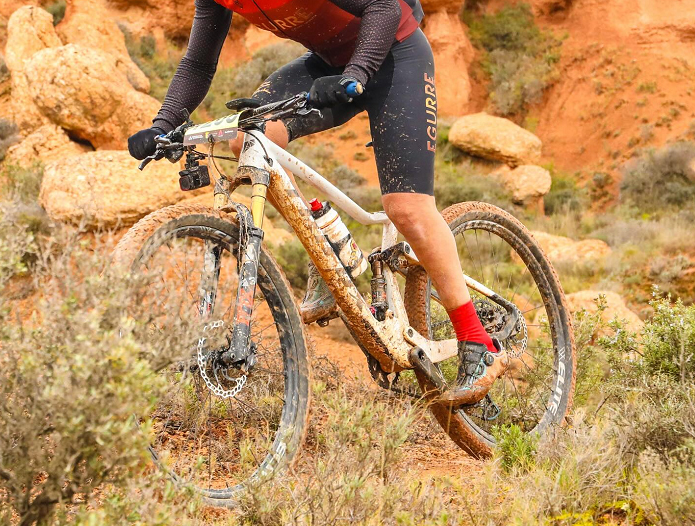
Whoa. $699 for a full suspension carbon mountain bike frame? That’s the headline grab from Trifox’s MFM100, and it immediately stops you in your tracks. In a world where carbon frames often command $2000+ just for the frame, this price point feels almost unreal. But is it too good to be true? Let’s break it down.
The Allure is Obvious:
Carbon Construction: Getting a carbon main frame and rear triangle at this price is unprecedented. Carbon offers the classic benefits: lightweight potential, stiffness where you want it, and vibration damping.
Modern Geometry: Trifox lists a slack-ish 66.5° head angle and a steeper 76° seat angle, fitting current trail/enduro trends. Reach numbers seem reasonable for modern sizing.
Suspension Design: It uses a Horst Link (4-bar) platform, a proven design known for its pedaling efficiency and bump compliance, adjustable via the shock's settings.
Boost Spacing, Internal Routing: Caters to contemporary components and cleaner looks.
The Price: Let's state it again: $699. This is cheaper than many high-end aluminum frames, let alone carbon.
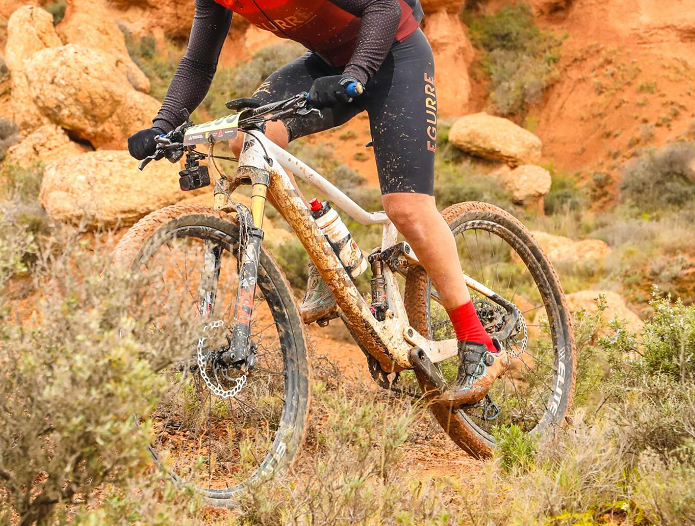
Who is this REALLY for?
The Savvy Tinkerer: Someone with deep mechanical knowledge, existing high-end components to swap over, and a willingness to potentially troubleshoot frame issues or bearing tolerances. They understand the risks.
The Budget-Pushed Builder: Riders determined to get onto a carbon full-sus platform with absolute minimal frame cost, accepting the compromises and risks. Only if they have realistic expectations.
The Trifox MFM100 is undeniably fascinating. It forces a conversation about frame manufacturing costs and DTC disruption. For $699, you get a modern-geometry, carbon full-suspension frame on paper.
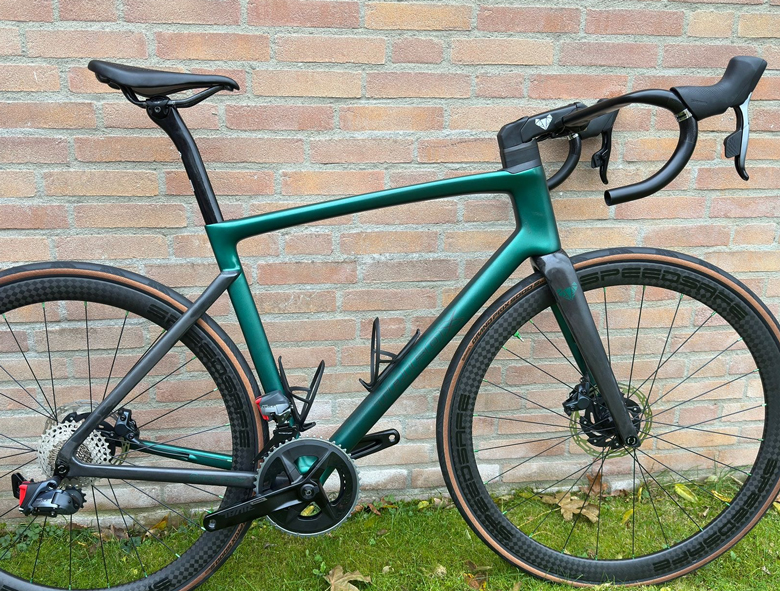
The short answer? Yes, often. Disc brakes (especially hydraulic ones) add bulk near your bike's wheel hubs, and not all bike racks handle this well. Using the wrong rack risks damaging your brakes, frame, or wheels. Here’s what to know:
The Problem: Clearance & Contact
- Frame Contact: Many traditional hanging-style racks (where the bike dangles from its top tube) use support arms that clamp near the fork crown or seatstay bridge – exactly where disc calipers sit. This can crush brake lines or bend calipers.
- Wheel Trays: Racks that hold bikes by the wheels need trays wide enough to accommodate disc rotors without bending them. Narrow trays can bend rotors if forced.
Rack Types That WORK with Disc Brakes:
1. Platform (Tray-Style) Racks (Best Option):
-Why: Bikes are secured by the wheels, not the frame. Look for:
Wide, open wheel trays that easily clear rotors.
Adjustable wheel chocks or ratcheting arms that grip tires/rims only, avoiding the brake area.
2. Hitch-Mounted Racks with Frame Grips (Carefully):
- Look for: Models specifically designed with disc brake clearance. They feature:
Frame grip arms shaped to curve around disc calipers.
Adjustable arm angles to avoid contact points.
- Always visually confirm the arms never touch the caliper or hose when clamped.
3. Roof Racks (Usually Fine):
- Why: Fork-mount trays clamp the fork dropout (far from the brake). Wheel-mount trays hold the wheel itself. Just ensure the fork mount adapter (if needed) doesn't interfere with a front disc.
Racks to AVOID (Generally):
- Basic Hanging Racks (Trunk/Roof/Hitch): These almost always clamp the frame top tube or seat tube, forcing the support arms directly into the disc calipers on the fork and rear triangle. High risk of damage.
Key Buying Tips:
1. Look for "Disc Brake Compatible": This is the easiest starting point, but still inspect.
2. Check the Support Points: Physically see (or find detailed photos/videos) showing where the rack contacts YOUR bike. Ensure calipers and hoses are untouched.
3. Prioritize Wheel Holders: Platform/tray racks are the safest, most versatile bet.
4. Measure Rotor Size (Especially for Fat Bikes/E-MTBs): Very large rotors need extra-wide trays.
The Bottom Line:
Don't risk costly brake damage! While some traditional racks might fit certain disc-brake bikes by luck, it's essential to choose a rack explicitly designed or verified for disc brake clearance. Invest in a quality platform-style rack or a frame-grip hitch rack with proven disc compatibility. Your brakes (and wallet) will thank you!
Ready for a high-performance disc brake road bike? Explore disc-compatible designs like the Trifox carbon series.
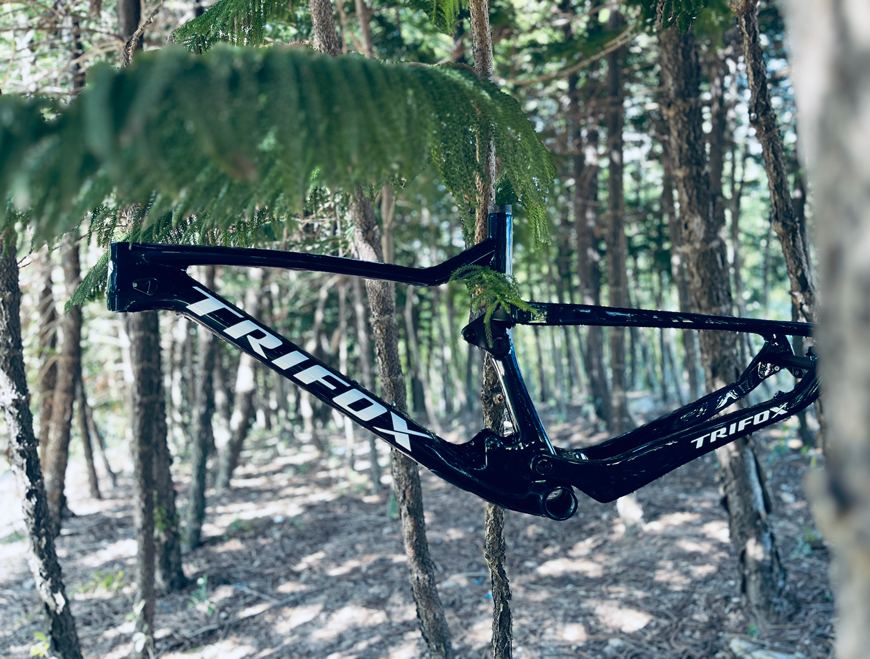
The age-old debate between hardtail (front suspension only) and full-suspension mountain bikes boils down to one question: What kind of rider are you? Let’s dissect the pros, cons, and ideal use cases for both setups to help you decide—and explore how brands like Trifox cater to diverse preferences.
Hardtail (Without Rear Suspension)
Pros:
- Lightweight: Fewer parts mean easier climbing and faster acceleration.
- Lower Cost: Affordable to buy and maintain (no rear shock or pivot bearings).
- Efficiency: Direct power transfer makes pedaling feel responsive, ideal for smooth trails or XC racing.
- Simplicity: Less maintenance and easier DIY repairs.
Cons:
- Rough Ride: Rear impacts are absorbed solely by your legs, leading to fatigue on technical terrain.
- Traction Limits: Less control on loose or rocky descents.
Full-Suspension
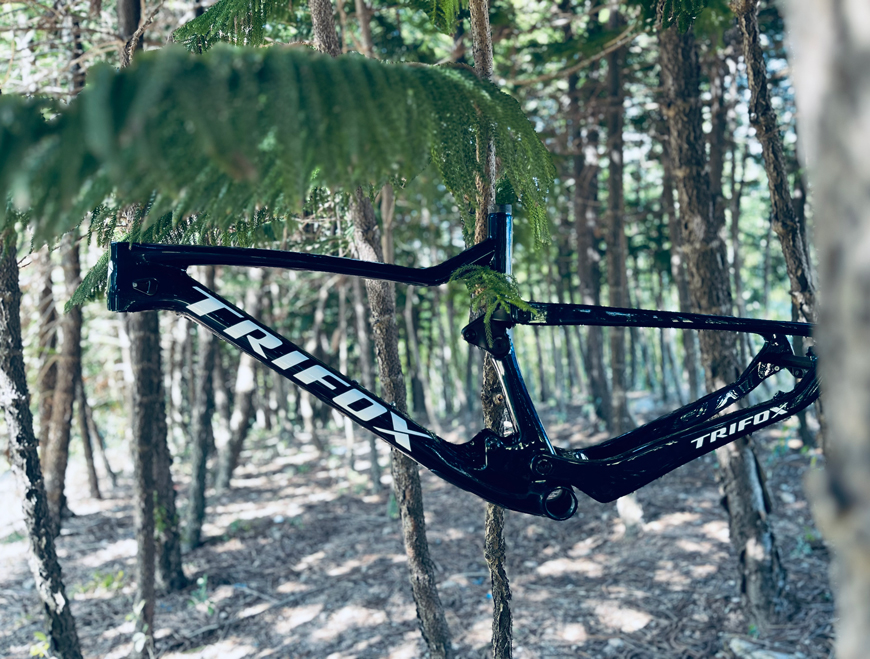
Pros:
- Comfort & Control: Rear shocks smooth out bumps, reducing fatigue and improving grip on chunky trails.
- Versatility: Confidently tackle downhill, enduro, or all-day adventures.
- Speed: Maintain momentum through rough sections.
Cons:
- Weight & Cost: Heavier frame and higher upfront/maintenance costs.
- Complexity: More moving parts mean more potential for mechanical issues.
Who Should Ride What?
- Choose a Hardtail If: You prioritize budget-friendly efficiency, ride smoother trails, or love climbing. Models like Trifox’s hardtails excel here, blending lightweight frames with trail-ready geometry.
- Choose Full-Suspension If: You crave technical descents, endurance rides, or park laps. Trifox’s full-suspension bikes offer balanced travel and durability for aggressive terrain.
Key Considerations
1. Terrain: Rocks, roots, and drops? Full-suspension shines. Pavement or flow trails? Save weight with a hardtail.
2. Budget: Hardtails cost less upfront and long-term.
3. Skill Level: Beginners may appreciate a hardtail’s simplicity; advanced riders often leverage full-squish capabilities.
There's no “better” option—only what's better for you. Hardtails reward efficiency and simplicity, while full-suspension bikes unlock technical prowess and comfort. Test both if possible, and consider Trifox’s range to match your riding style. Whether you're chasing KOMs or sending drops, the right suspension setup ensures every ride feels like freedom.
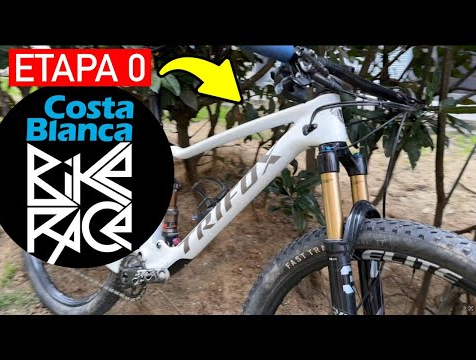
Mountain bikers, assemble! We’ve got something that's going to blow your mind—a surprise unboxing that might just reveal a glimpse of the future of mountain biking. Could this be a 2025 MTB?
In this thrilling video, we crack open a mysterious package that could be hiding the next big thing in trail technology. From the moment the box is opened, it’s clear this bike is something special. The sleek design, advanced components, and innovative features have us wondering if this is a prototype of what’s to come in 2025.
If you're as excited about full-suspension mountain bikes as we are, you’ll want to check out Trifox Bike’s incredible lineup. The full-suspension models are built for performance, durability, and all-out trail domination. Explore their collection here: Trifox Full-Suspension Mountain Bikes.
Whether this unboxing reveals a 2025 model or just a taste of cutting-edge innovation, one thing's for sure: the future of mountain biking looks incredibly bright. Don’t miss out—watch the video, share your thoughts, and get ready to hit the trails in style!

When it comes to mountain biking, especially for trail riders, choosing the right bike can make a world of difference. One of the most debated decisions among cyclists is whether to opt for a dual suspension bike or stick with a hardtail. Dual suspension bikes, which feature both front and rear shocks, are known for their ability to absorb impacts and provide a smoother ride on rough terrain. However, they come with a higher price tag and more maintenance. So, are dual suspension bikes really worth the investment for trail riders? Let’s break it down.
1. Superior Comfort on Rough Terrain
One of the most obvious advantages of dual suspension bikes is the comfort they provide. Trail riding often involves navigating rocky paths, bumpy trails, and obstacles that can create significant jolts and impacts. Hardtail bikes, which only have a suspension fork at the front, can transfer a lot of that shock directly to the rider, leading to discomfort, fatigue, and a less enjoyable ride.
Dual suspension bikes, like the Trifox Pioneer Bike, are equipped with both front and rear shocks that work together to absorb impact. This creates a much smoother ride, allowing you to handle rough terrain with greater ease. The rear suspension helps to absorb shocks from bumps and drops, making the ride more comfortable and reducing the risk of injury from jarring impacts. For trail riders who often encounter technical terrain or prefer longer rides, the added comfort of dual suspension can be a game-changer.
2. Better Control and Handling
Dual suspension bikes also offer superior control and handling compared to hardtails, especially on downhill and technical sections of the trail. The rear suspension helps to keep the rear wheel planted on the ground, improving traction and stability. This is particularly important when navigating loose gravel, wet conditions, or steep descents, where maintaining control is crucial.
The Trifox Pioneer Bike is designed with a robust dual suspension system that enhances handling, even in challenging conditions. The bike’s front and rear shocks work in unison to maintain tire contact with the ground, providing more consistent traction and allowing you to tackle technical sections with confidence. Whether you’re navigating tight switchbacks or blasting down a rocky descent, the improved stability and control that come with dual suspension can make a noticeable difference in your performance.
3. Reduced Fatigue on Long Rides
Riding on rough terrain can be exhausting, particularly on long rides. The constant jarring and bouncing of a hardtail bike can take a toll on your body, leading to fatigue and discomfort. On the other hand, dual suspension bikes reduce the impact forces that travel through your body, making the ride less taxing. This is especially beneficial for trail riders who enjoy longer rides or multi-day adventures.
The Trifox Pioneer Bike offers excellent suspension performance that helps reduce the strain on your arms, legs, and back. With the rear suspension absorbing much of the shock, riders can focus on the ride itself rather than worrying about fatigue or discomfort. If you’re planning on tackling challenging trails or going for long-distance rides, the added comfort and reduced fatigue provided by dual suspension will allow you to ride longer and harder without burning out.
4. Increased Safety and Confidence
A well-designed dual suspension system can also increase your safety on the trails. By providing better traction, stability, and control, these bikes help riders stay in control during high-speed descents, technical maneuvers, and challenging terrain. When you’re riding on a bike that feels stable and secure, you’re more likely to take on challenging obstacles with confidence.
The Trifox Pioneer Bike is equipped with advanced suspension technology that enhances both safety and performance. Whether you’re descending a steep hill or negotiating an uneven rock garden, the bike’s suspension keeps you in control and minimizes the risk of losing traction or control. This makes dual suspension bikes an excellent choice for riders who enjoy pushing their limits and tackling more advanced trail features.
5. The Cost vs. Benefits Debate
Of course, dual suspension bikes come with a higher price tag compared to hardtails. The additional cost is typically due to the more complex suspension systems, higher-quality components, and additional maintenance required. For some riders, especially those just starting out or those who primarily ride smooth trails, a hardtail might offer all the performance they need at a more affordable price.
However, for serious trail riders who often ride on rough, technical trails, the benefits of a dual suspension bike are hard to ignore. The increased comfort, better control, and reduced fatigue make the higher investment well worth it for riders who want to maximize their performance and enjoy a smoother, more enjoyable ride.
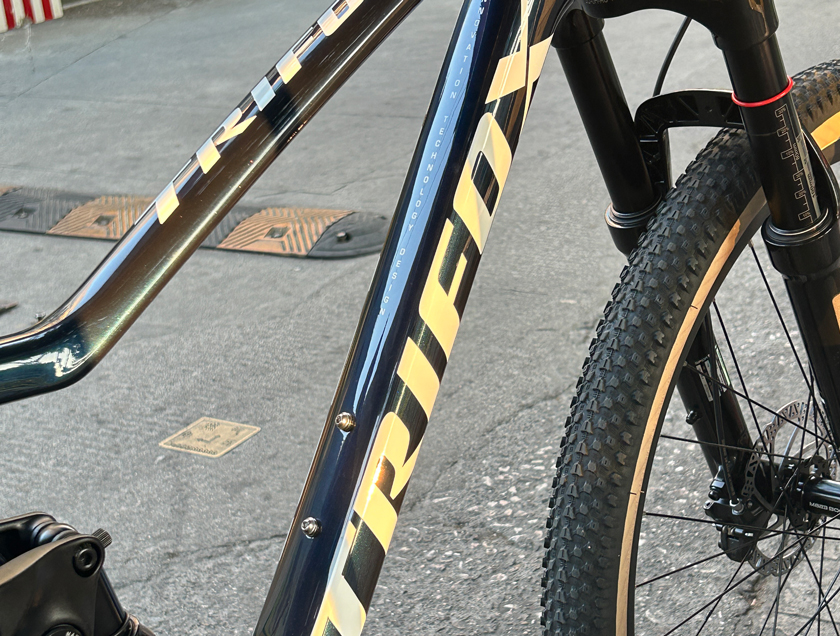
So, are dual suspension bikes really worth the investment for trail riders? The answer largely depends on the type of riding you do and your priorities as a cyclist. If you regularly ride on rough, technical terrain or enjoy long-distance trail rides, a dual suspension bike like the Trifox Pioneer Bike can significantly improve your ride quality, comfort, and performance. While they do come with a higher price tag, the added benefits of better control, reduced fatigue, and increased safety make them an excellent choice for serious trail riders who want to take their biking experience to the next level.

If you're new to mountain biking or just exploring the different types of bikes available, you may have come across the term “suspension bike.” But what exactly does that mean, and how does it affect your riding experience? Whether you're hitting rugged trails, tackling rocky descents, or simply exploring the outdoors, suspension bikes are designed to provide better comfort, control, and performance on rough terrain. In this post, we’ll break down what suspension bikes are, how they work, and why they might be the right choice for you.
What Is a Suspension Bike?
A suspension bike is a type of bicycle that is equipped with a suspension system to absorb shock and reduce the impact of rough terrain. Unlike traditional rigid bikes, which have a solid frame and fork, suspension bikes feature shock-absorbing components in the front (the fork) and/or the rear (the frame or rear shock). This suspension system helps smooth out bumps, rocks, and other obstacles on the trail, giving riders a more comfortable and controlled experience.
There are two main types of suspension bikes: front suspension (also known as hardtail) and full suspension. Let’s explore each type in more detail.
Front Suspension (Hardtail)
A front suspension bike, or hardtail, has a shock-absorbing fork at the front of the bike but does not have suspension in the rear. The fork is designed to absorb shocks from obstacles like rocks, roots, and bumps, helping to keep your hands and arms from getting jarred. Hardtail bikes are generally lighter, more efficient, and require less maintenance than full-suspension bikes, making them an excellent choice for cross-country riders or those who primarily ride on less technical terrain.
Advantages of Front Suspension Bikes:
- Lighter weight
- More efficient pedaling (especially on smooth trails)
- Lower maintenance costs
- Ideal for cross-country and less technical riding
Disadvantages:
- Less control and comfort on very rough or technical terrain compared to full-suspension bikes
Full Suspension
Full suspension bikes, as the name suggests, have both front and rear suspension systems. The front fork absorbs impacts from the terrain, while the rear shock (or shock absorber) does the same for the rear of the bike. This system is ideal for riders tackling more technical trails, downhill tracks, or rugged mountain routes, as it significantly enhances comfort and control. The rear suspension helps maintain traction, preventing the rear wheel from bouncing off the ground and giving you better control over the bike’s handling.
The rear shock in full suspension bikes can be adjusted for different types of terrain, allowing riders to fine-tune the bike’s performance based on their specific needs.
Advantages of Full Suspension Bikes:
- Better comfort and control on rough terrain
- Increased traction and stability, especially on downhill or technical trails
- More forgiving ride for beginners or those new to mountain biking
Disadvantages:
- Heavier than hardtail bikes
- Requires more maintenance due to additional components
- More expensive compared to front suspension bikes
How Does a Suspension Bike Work?
Suspension systems use a combination of springs and dampers to absorb and control shock. When the bike encounters a bump, rock, or other obstacles, the suspension compresses to absorb the impact, and then it returns to its original position, thanks to the spring and damper combination. The damper controls the speed of the spring’s return, ensuring a smooth and controlled recovery. This reduces the jarring feeling you would otherwise experience on a rigid bike, improving overall comfort and stability.
Key Components of a Suspension System:
1. Fork (Front Suspension): The fork absorbs the shock at the front of the bike and helps keep your hands and arms steady when riding over rough terrain.
2. Rear Shock (Full Suspension): The rear shock absorbs impacts in the rear of the bike, providing additional comfort and traction.
3. Shock Absorbers (Springs and Dampers): These are the core components that control the compression and rebound of the suspension, ensuring that the ride is smooth and stable.
Why Choose a Suspension Bike?
If you're planning on riding in rough or rocky terrain, or if you want to tackle more technical trails, a suspension bike will make a significant difference in your experience. Suspension bikes are designed to enhance control and comfort, especially on uneven or bumpy surfaces. Here are a few reasons why you might opt for a suspension bike:
- Improved Comfort: Suspension systems help reduce the impact of bumps and vibrations, leading to a more comfortable ride. This is especially important for long rides or trails with lots of obstacles.
- Better Control: With both front and rear suspension, you get more traction and stability, helping you maintain control when going over rough terrain, steep descents, or obstacles.
- Increased Confidence: A suspension bike makes it easier to navigate technical trails without worrying about losing control or hurting yourself from the impact of bumps and drops.
- Versatility: Suspension bikes, particularly full-suspension models, are great for a wide range of terrains, from cross-country routes to downhill trails.
The Trifox MFM100 Full Suspension Carbon MTB Frame
For those looking to invest in a high-performance mountain bike, the [Trifox MFM100 Full Suspension Carbon MTB Frame] is an excellent option. Featuring a lightweight, durable carbon fiber frame and advanced suspension technology, this bike offers enhanced shock absorption, traction, and overall control, making it perfect for mountain biking enthusiasts looking to take on challenging terrains. With its stiff and responsive frame design, the Trifox MFM100 is an ideal choice for riders who want the perfect balance of comfort, performance, and durability.
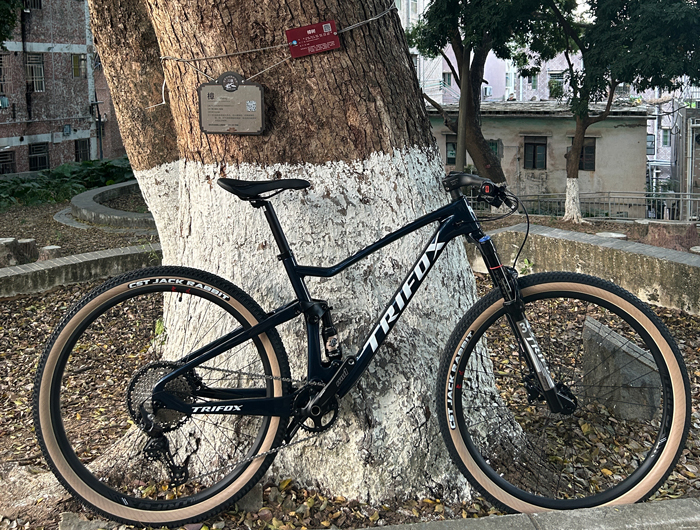
Final Thoughts
Whether you opt for a front suspension (hardtail) or full suspension bike, suspension systems are a key feature for riders who want to improve comfort and performance on rough terrain. By absorbing shocks and maintaining traction, suspension bikes make riding on challenging trails smoother and more enjoyable. With options ranging from lightweight hardtails to full-suspension models like the Trifox MFM100, there’s a bike to suit every type of rider and riding style.


























































